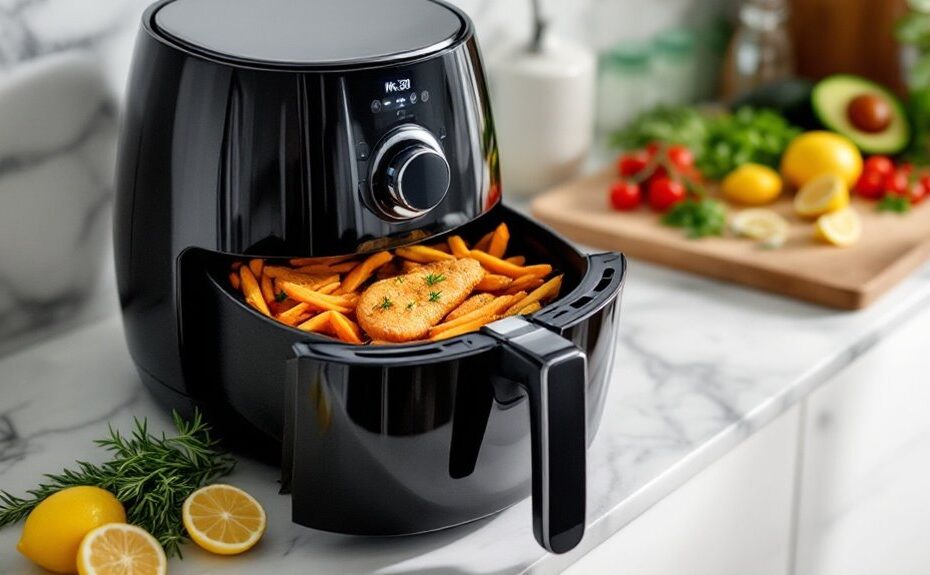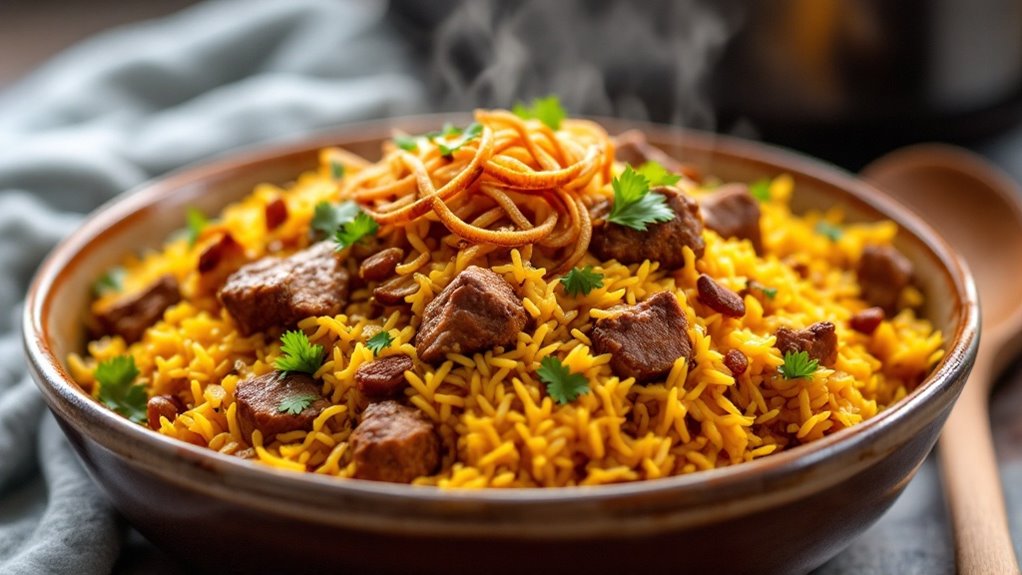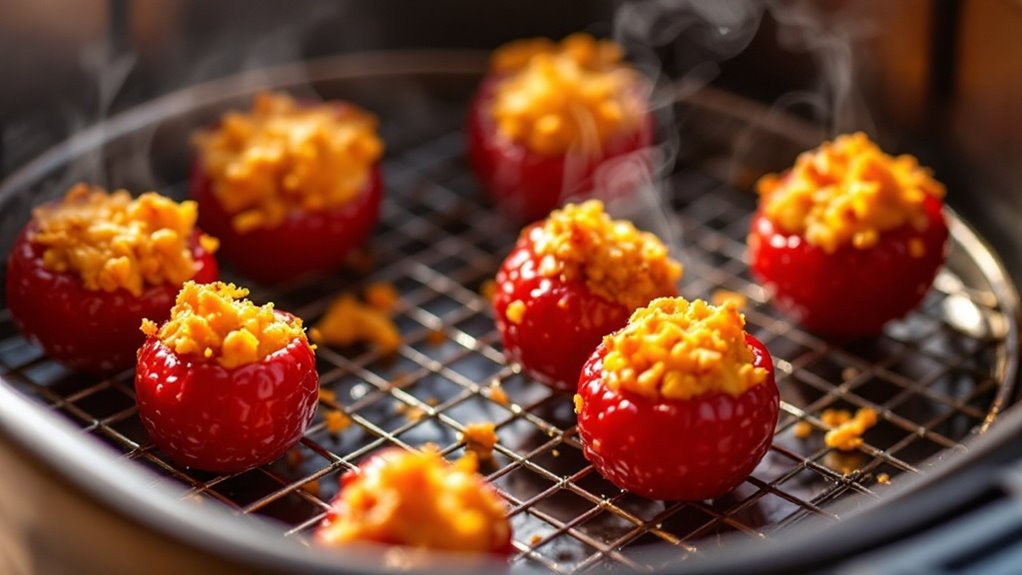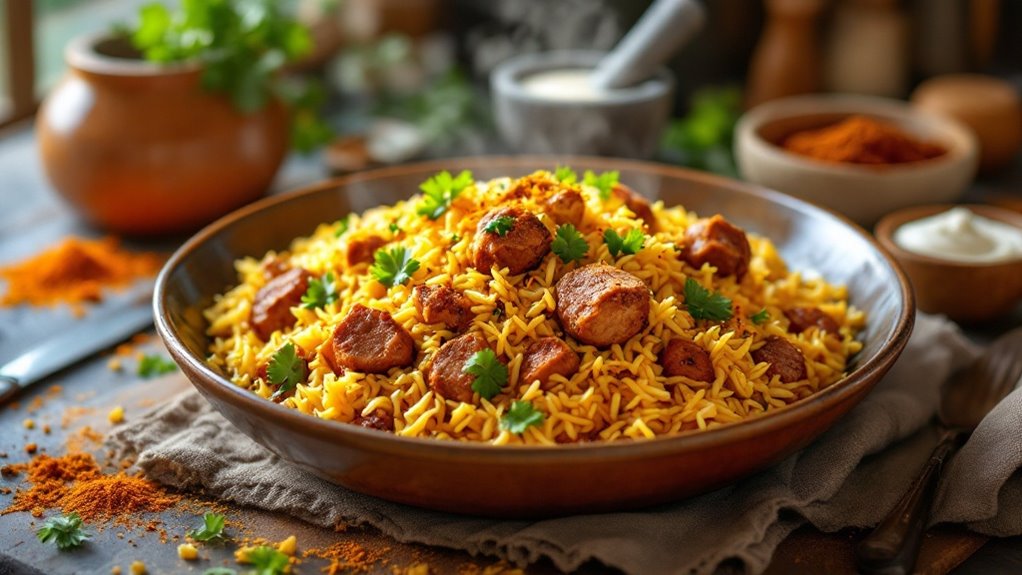An air fryer can transform your Whole30 journey by turning simple ingredients into crispy, satisfying meals without compromising the diet's strict guidelines. You'll need to master a few techniques, like preheating the appliance and using compliant oils, to guarantee your dishes stay flavorful and compliant. But what if you could make crunchy snacks without breadcrumbs or perfectly roasted vegetables in half the time? The key lies in understanding how to maximize your air fryer's potential while sticking to Whole30 principles. Discover how to elevate your meals and simplify your routine with just a few adjustments.
Key Takeaways
- Use compliant oils like avocado or olive oil for air frying Whole30-approved vegetables, proteins, and snacks.
- Preheat the air fryer to 400°F and avoid overcrowding the basket for even, crispy results.
- Choose Whole30-compliant ingredients, such as fresh vegetables, lean proteins, and healthy fats, and avoid processed additives.
- Cook vegetables at 375°F for 10-15 minutes, shaking halfway, and adjust times based on density for optimal texture.
- Prepare proteins like chicken or salmon at 375°F for 10-15 minutes, flipping halfway for even cooking and crispiness.
Understanding Whole30 Diet Guidelines
The Whole30 diet is a 30-day elimination plan designed to reset your eating habits by removing potentially inflammatory foods like sugar, grains, dairy, legumes, and processed additives. During this period, you'll focus on whole, unprocessed foods such as vegetables, fruits, lean proteins, and healthy fats. Whole30 meal prep is essential for success, as it helps you stay compliant and avoid temptations. Using an air fryer can simplify cooking, but you must follow air fryer safety tips to guarantee proper use. Always preheat the appliance, avoid overcrowding the basket, and clean it regularly to prevent cross-contamination. By adhering to these guidelines, you'll maximize the benefits of Whole30 while maintaining a safe and efficient cooking routine.
Choosing the Right Air Fryer
When selecting an air fryer for your Whole30 journey, it's important to evaluate factors like capacity, ease of use, and functionality. Air fryer capacity determines how much food you can cook at once, so choose one that suits your household size—typically 2-6 quarts for individuals or small families. Larger capacities are ideal for meal prepping. Air fryer wattage impacts cooking speed and efficiency; models with 1,500-1,800 watts heat quickly and evenly, ensuring consistent results. Look for intuitive controls and dishwasher-safe components to simplify cleanup. Prioritize models with adjustable temperature settings and timers for precise cooking. Avoid unnecessary features that don't align with Whole30 needs, focusing instead on durability and performance. A well-chosen air fryer enhances your ability to prepare compliant meals efficiently.
Essential Whole30 Air Fryer Accessories
To maximize your air fryer's potential during Whole30, investing in a few key accessories can streamline meal prep and guarantee compliance. Air fryer liners are essential for easy cleanup and preventing food from sticking, ensuring you avoid non-compliant oils. Opt for parchment or silicone liners designed for your specific air fryer model. Silicone baking mats are another versatile tool, ideal for roasting vegetables or reheating leftovers without added fats. These mats are reusable, heat-resistant, and simplify adherence to Whole30 guidelines. Additionally, consider a non-toxic, BPA-free rack or basket to maximize cooking space and improve airflow for even results. These accessories not only enhance efficiency but also support your commitment to Whole30 principles by minimizing cross-contamination and simplifying meal preparation.
Prepping Ingredients for Air Frying
Start by selecting Whole30-compliant ingredients, ensuring they align with the program's guidelines. Thoroughly wash and dry your produce to remove contaminants and prevent steaming in the air fryer. Cut ingredients into uniform sizes to promote even cooking and consistent results.
Choose Whole30-Compliant Ingredients
Selecting Whole30-compliant ingredients is essential for guaranteeing your air-fried meals align with the program's guidelines. Focus on whole, unprocessed foods like fresh vegetables, lean proteins, and healthy fats. Avoid grains, dairy, legumes, added sugars, and processed additives. For Whole30 recipes, use ingredient substitutions like coconut aminos instead of soy sauce or almond flour for breading. Check labels carefully to avoid hidden non-compliant ingredients, such as sulfites or carrageenan. Prioritize organic produce and grass-fed, pasture-raised meats when possible to maximize nutrient density. By choosing high-quality, compliant ingredients, you'll create flavorful, nutrient-rich meals that support your Whole30 journey while leveraging the air fryer's efficiency. This approach confirms your dishes are both delicious and aligned with the program's principles.
Properly Wash and Dry Produce
Before air frying, it's crucial to thoroughly wash and dry your produce to remove dirt, pesticides, and potential contaminants. Start by rinsing fruits and vegetables under cool running water, scrubbing firm items like potatoes with a brush to eliminate residue. For leafy greens, separate leaves and soak them in a bowl of water, then rinse to guarantee thorough cleaning. Avoid using soap or detergents, as they can leave harmful residues. After washing, pat produce dry with a clean towel or use a salad spinner for greens to prevent excess moisture, which can affect air frying results. Follow produce storage tips to keep items fresh before prepping. These washing techniques guide you in maintaining food safety and quality for your Whole30 meals.
Cut Ingredients for Even Cooking
To guarantee your ingredients cook evenly in the air fryer, cutting them into uniform sizes is essential. Even slicing promotes consistent heat distribution, preventing some pieces from overcooking while others remain underdone. For vegetables, aim for uniform pieces about the same thickness, such as ½-inch cubes or slices. When preparing proteins like chicken or fish, cut them into similar-sized portions to encourage even browning and cooking. Smaller, uniform pieces also allow for better airflow, a key factor in air frying. Avoid overcrowding the basket, as this can lead to uneven results. By taking the time to prep your ingredients with precision, you'll achieve perfectly cooked meals every time, aligning with your Whole30 goals.
Cooking Vegetables in the Air Fryer
Choose vegetables like broccoli, zucchini, or Brussels sprouts that hold up well to air frying. Cut them into even-sized pieces and lightly coat them with oil to guarantee crisp, even cooking. Set your air fryer to 375°F and cook for 10-15 minutes, shaking the basket halfway through for consistent results.
Choosing the Right Vegetables
When cooking vegetables in an air fryer for Whole30, selecting the right ones guarantees ideal texture and flavor. Focus on seasonal produce, as it's fresher, more nutrient-dense, and often more affordable. For vegetable selection, choose options that crisp well, such as broccoli, zucchini, Brussels sprouts, or cauliflower. Root vegetables like sweet potatoes and carrots also work beautifully, as their natural sugars caramelize during cooking. Avoid overly watery vegetables, such as cucumbers or lettuce, as they won't achieve the desired crispness. Prioritize firm, fresh vegetables that hold their shape under high heat. By aligning your choices with Whole30 guidelines and the air fryer's capabilities, you'll maximize flavor and texture while adhering to the diet's principles.
Preparing Vegetables Properly
Since air fryers rely on rapid hot air circulation, properly preparing your vegetables guarantees even cooking and ideal crispness. Start by washing and thoroughly drying your vegetables to prevent steaming. Cut them into uniform sizes to secure consistent cooking times. Lightly coat them with a Whole30-compliant oil, such as avocado or olive oil, to enhance browning and texture. Apply vegetable seasoning sparingly, using herbs, spices, or salt-free blends to keep your dish compliant. Avoid overcrowding the air fryer basket, as this can block airflow and lead to uneven results. For denser vegetables like sweet potatoes, increase cooking times slightly, while softer options like zucchini require less time. Proper preparation assures your vegetables are crispy, flavorful, and perfectly cooked every time.
Optimal Air Fryer Settings
To achieve the best results when cooking vegetables in an air fryer, it's essential to adjust the temperature and time based on the type and size of the vegetables. For tender vegetables like zucchini or asparagus, set the temperature control to 350°F and cook for 8-10 minutes. Denser vegetables, such as broccoli or Brussels sprouts, require higher heat—around 400°F—for 12-15 minutes. Always preheat the air fryer to guarantee even cooking. Cut vegetables into uniform sizes to prevent uneven results, and shake the basket halfway through cooking times to promote crispness. Avoid overcrowding the basket, as this can lead to steaming instead of roasting. Experiment with small adjustments to find the perfect balance for your preferred texture and doneness.
Making Whole30-Compliant Protein Dishes
While the Whole30 diet emphasizes whole, unprocessed foods, an air fryer can simplify preparing protein-rich dishes that adhere to its guidelines. Start by selecting lean proteins like chicken breast, turkey, or salmon, guaranteeing they're free from added sugars or non-compliant additives. Use protein seasoning tips to enhance flavor without compromising Whole30 rules—opt for spices like paprika, garlic powder, or cumin. For marinating techniques, combine compliant ingredients like olive oil, lemon juice, and fresh herbs to tenderize and infuse flavor. Preheat your air fryer to make certain even cooking, then cook proteins at 375°F for 10-15 minutes, flipping halfway through. This method locks in moisture while achieving a crispy exterior, making it easier to enjoy satisfying, Whole30-compliant meals.
Avoiding Non-Compliant Oils and Ingredients
When using your air fryer for Whole30, select compliant cooking oils like avocado or coconut oil to avoid processed or non-compliant fats. Always check ingredient labels carefully to guarantee no added sugars, grains, or dairy are present in your recipes. Minimize cross-contamination risks by thoroughly cleaning your air fryer basket and avoiding shared cooking surfaces with non-compliant foods.
Choose Compliant Cooking Oils
Since the Whole30 diet emphasizes whole, unprocessed foods, selecting compliant cooking oils is essential for maintaining its guidelines. Focus on oil selection tips that prioritize healthy fat options like avocado oil, coconut oil, and extra virgin olive oil. These oils are minimally processed, rich in beneficial fats, and align with Whole30 principles. Avoid non-compliant oils such as soybean, canola, and vegetable oils, which are often highly refined and inflammatory. When using an air fryer, opt for oils with high smoke points, like avocado oil, to prevent oxidation and maintain nutritional integrity. Always check for purity and avoid blends containing non-compliant ingredients. By choosing the right oils, you'll enhance flavor, support your health, and stay true to the Whole30 program.
Check Ingredient Labels Carefully
To guarantee your air fryer meals align with the Whole30 diet, you'll need to scrutinize ingredient labels meticulously, as many products contain hidden non-compliant oils and additives. Use label verification tips like checking for soy, canola, or vegetable oils, which are prohibited. Look for terms like "natural flavors" or "spices," as these can mask non-compliant ingredients. Prioritize ingredient sourcing strategies by selecting whole, unprocessed foods and opting for brands with transparent labeling. Avoid products with added sugars, dairy, or grains, even in trace amounts. When in doubt, choose single-ingredient items or consult Whole30-approved resources. By carefully reviewing labels, you'll confirm your air-fried meals remain compliant and support your dietary goals effectively.
Avoid Cross-Contamination Risks
Cross-contamination can compromise your Whole30 compliance, especially when using an air fryer shared with non-compliant foods. To maintain allergen-free cooking and adhere to Whole30 guidelines, clean your air fryer thoroughly before use. Remove any residue from non-compliant oils or ingredients, as even small traces can affect your results. Use separate utensils and trays for Whole30-compliant meals to prevent mixing with non-compliant items. If sharing the appliance, consider designating specific times or compartments for Whole30 cooking. Follow food safety tips by washing your hands and surfaces before preparing meals. Store compliant and non-compliant ingredients separately to avoid accidental exposure. These practices guarantee your air fryer remains a safe tool for allergen-free cooking, helping you stay on track with your Whole30 goals.
Creating Crispy Snacks Without Breadcrumbs
When following the Whole30 diet, you can still achieve crispy snacks without breadcrumbs by leveraging the air fryer's high-heat cooking method. For crispy zucchini fries, slice zucchini into sticks, coat them lightly with olive oil, and season with compliant spices like garlic powder or paprika. Arrange them in a single layer in the air fryer basket and cook at 400°F for 10-12 minutes, flipping halfway. For crunchy kale chips, toss kale leaves with a small amount of olive oil and salt, then air fry at 375°F for 5-7 minutes until crisp. Avoid overcrowding the basket to guarantee even cooking. These methods rely on the air fryer's rapid circulation of hot air to create a satisfying crunch without the need for breadcrumbs or non-compliant ingredients.
Cleaning and Maintaining Your Air Fryer
Since regular cleaning guarantees your air fryer functions at its best and lasts longer, establishing a consistent maintenance routine is essential. After each use, unplug the appliance and let it cool completely. Remove the basket and tray, then wash them with warm, soapy water or place them in the dishwasher if they're dishwasher-safe. Use a non-abrasive sponge to avoid scratching surfaces. Wipe the interior and exterior with a damp cloth, making certain no food residue remains. For stubborn grease, apply a baking soda paste and gently scrub. Avoid submerging the main unit in water. Regularly inspect the heating element for debris and clean it with a soft brush. These cleaning techniques and maintenance tips will help preserve your air fryer's performance and make sure it remains a reliable tool for your Whole30 meals.
Meal Planning With Air Fryer Recipes
To streamline your Whole30 meal prep, incorporating air fryer recipes into your planning can save time and guarantee compliance with the program's guidelines. Start by selecting recipes that align with Whole30 principles, focusing on whole, unprocessed ingredients like vegetables, proteins, and healthy fats. Use meal prep tips such as batch cooking proteins like chicken or salmon in the air fryer to create versatile bases for multiple meals. Adapt traditional recipes by swapping non-compliant ingredients with Whole30-approved alternatives, such as using coconut aminos instead of soy sauce. Plan meals in advance, ensuring you have compliant snacks like air-fried sweet potato fries or zucchini chips ready. This approach minimizes decision fatigue and keeps you on track throughout the program.
Disclosure: As an Amazon Associate, I earn from qualifying purchases.



